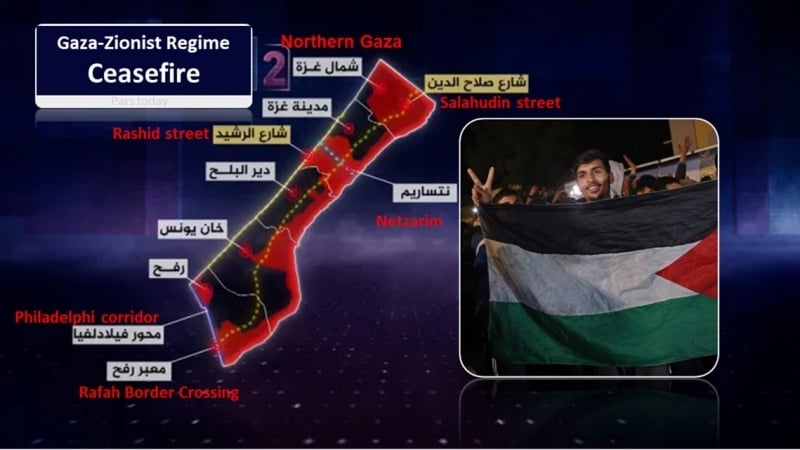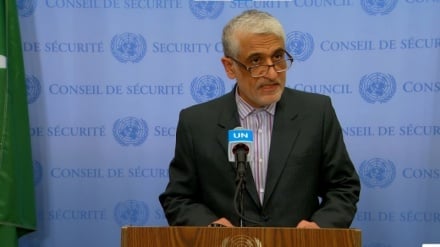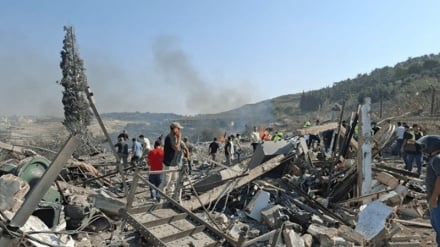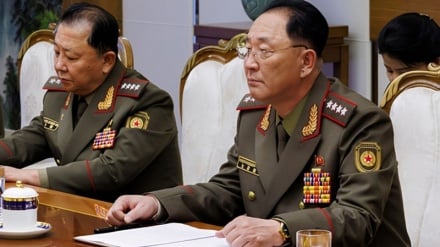Pars Today's Iran and world news package
Text of ceasefire agreement between Hamas, Israeli regime
Pars Today - The ceasefire agreement reached on Wednesday night between the Israeli regime and Hamas, which includes a captive exchange, consists of three phases aimed at ending the war in Gaza.
After a year and three months of brutal warfare and failing to achieve its objectives—such as freeing its captured military forces through ground intervention, eliminating the popular resistance of Hamas, and dismantling Gaza's military capability to use rockets—the Zionist regime finally agreed to a ceasefire with the Palestinian Islamic Resistance Movement, Hamas, on Wednesday night.
According to Pars Today, citing al-Aam, this agreement consists of three phases and will come into effect on Sunday, January 19. The text of the agreement, titled "General Principles of the Agreement Between the Israeli and Palestinian Parties in Gaza Regarding Prisoner Exchange and the Establishment of a Sustainable Ceasefire," is as follows:
All Israeli prisoners, both alive and deceased, who have been captured by the resistance, will be released. In return, the Israeli regime has agreed to release a number of Palestinian prisoners, as mutually agreed upon.
The exchange will begin on the day of the ceasefire, referred to as "Day One" in the agreement.
The Israeli regime and Hamas have agreed in this document to a ceasefire that will lead to four objectives:
- A permanent ceasefire,
- The withdrawal of Israeli forces from the Gaza Strip,
- The reconstruction of Gaza, and
- The reopening of crossings to facilitate the movement of people and the transportation of goods.
The terms of the agreement are divided into three phases as follows:
First phase (42 days):
Temporary halt to military operations by both sides and the withdrawal of the Israeli army eastward from "populated areas along the border in all regions of the Gaza Strip, including Wadi Gaza (Netzarim axis)."
Temporary suspension of aerial (military and surveillance) movement in the Gaza Strip for 10 hours a day and 12 hours on days when prisoner exchanges take place.
Return of displaced persons to their homes and exit from Wadi Gaza.
On the seventh day (after the release of seven Zionist captives), the forces of the Israeli occupation regime will fully withdraw from the coastal Rashid Road eastward to Salah al-Din Road.
Israel has committed to completely dismantling its military bases and installations in this area, thereby allowing the return of displaced persons to their residences (without carrying weapons). Freedom of movement for people in all areas of the Gaza Strip will be unrestricted, and the entry of humanitarian aid will begin without limitations from the first day.
On the twenty-second day, Israeli forces will withdraw from central Gaza (particularly the Netzarim axis east of Salah al-Din Road to the area along the border), and military bases and installations will be completely dismantled.
From the first day, humanitarian aid will be permitted (600 trucks per day, including 50 fuel trucks, with 300 of them allocated to the northern Gaza Strip). This includes fuel required to operate the power plant, as well as commercial and construction equipment needed for debris removal, reconstruction, and the operation of hospitals.
captive exchange:
Hamas will release 33 Israeli captives (non-military women and soldiers), children (under 19 years old and not soldiers), adults (over 50 years old), and sick or injured civilians.
In return, the Zionist regime will release a number of Palestinian prisoners. Considering the lists provided by Hamas based on the priority of their arrest, Israel will release 30 Palestinian women and children for every woman or child released by Hamas.
Additionally, based on the list provided by Hamas according to the priority of their arrest, for every elderly or sick Zionist released by Hamas, Israel will release 30 adult and sick prisoners (with up to 15 years remaining in their imprisonment).
For every female soldier released, Israel will release 50 Palestinian prisoners (30 serving life sentences and 20 serving sentences of up to 15 years).
This applies to the lists provided by Hamas, except for the agreed-upon list. The number of Palestinian prisoners (at least 100) will be discussed in the second phase. Some of them will be released and deported abroad or to Gaza.
Mechanism for captive exchange in the first phase:
On the first day, Hamas will release three Israeli civilians, and on the seventh day, four more civilians. After that, Hamas will release three Israeli prisoners every seven days, starting with women.
It was decided that all living Israeli prisoners would be released before the bodies, and in the sixth week, Hamas will release all remaining prisoners in this phase in exchange for the agreed number of Palestinian prisoners in Israeli prisons. This release will occur simultaneously based on the lists provided by Hamas.
By the seventh day, Hamas will provide information on the number of Israeli prisoners to be released in this phase.
In the sixth week (after the release of "Hisham al-Sayed" and "Efra Mengistu," bringing the total to 33 Israeli captives), Israel will release 47 prisoners who were rearrested under the Shalit agreement.
If the number of living Israeli prisoners to be released in this phase does not reach 33, the remaining number will be completed by returning bodies. In return, Israel will release all women and children (under 19 and non-combatants) arrested in the Gaza Strip after October 7.
Israel has committed not to rearrest the released Palestinians on the same charges and will not return released Palestinian prisoners to serve the remainder of their sentences.
It was also agreed that released Palestinians will not be required to sign any documents as a condition for their release.
Both sides agreed that the initiation of this captive exchange will not serve as a basis for initiating exchanges in the second phase.
By the sixteenth day at the latest, indirect negotiations between the two sides will begin to agree on the conditions for implementing the second phase, particularly regarding the initiation of captive exchanges.
Negotiations will be completed and finalized by the end of the fifth week of this phase.
The United Nations, its agencies, and other organizations will continue to provide humanitarian services in all areas of the Gaza Strip.
Reconstruction of infrastructure (electricity, water, sewage, communications, and roads) across Gaza will begin, along with the delivery of the agreed-upon amount of equipment necessary for civil defense (rescue organizations).
Facilitation of the entry of supplies and materials to house displaced persons who lost their homes in the war. At least 60,000 caravans and 200,000 tents will be brought in.
After the release of all Israeli female soldiers, a number of Hamas wounded will be designated to travel to the Rafah crossing for treatment. Additionally, the number of travelers, patients, and wounded passing through the Rafah crossing will increase, travel restrictions will be lifted, and the movement of goods and trade will resume.
Measures and programs for the comprehensive reconstruction of homes, civilian facilities, and civilian infrastructure destroyed during the war will begin, supported by several countries and organizations, including Egypt, Qatar, and the United Nations.
All measures in this phase, including the military ceasefire, will continue into the second phase as long as negotiations on the conditions for its implementation continue.
The agreement stipulates that Qatar, the United States, and Egypt will make every effort to ensure the continuation of indirect negotiations until the two sides can agree on the conditions for implementing the second phase.
Phase two (42 days):
A permanent ceasefire (cessation of military operations and aggressive actions in a systematic manner) will be declared and will begin before the prisoner exchange.
The agreement states: "Here, we are talking about all remaining living Israeli prisoners, in exchange for the release of a number of Palestinian prisoners in Israel." During this phase, the complete withdrawal of the Israeli army from the Gaza Strip will take place.
Phase three (42 days):
The exchange of all bodies between the two parties after determining their locations and identification.
Implementation of a 3 to 5-year reconstruction plan for the Gaza Strip, including housing, urban facilities, civilian infrastructure, and support for victims under the supervision of countries and organizations such as Egypt, Qatar, and the United Nations. The reopening of border crossings and facilitation of the movement of people and goods.
The Zionist regime, with the support of the United States and Western countries, launched a devastating war against the Gaza Strip on October 7, 2023. As a result, in addition to massive destruction, over 46,000 Palestinians, most of whom were women and children, were martyred, and at least 100,000 others were injured. Despite all these crimes, the Zionist regime admitted that after 467 days of war against the residents of Gaza, it had failed to achieve its objectives in this war, namely the destruction of Palestinian resistance and the return of Zionist prisoners from the Gaza Strip.
MG/UR



